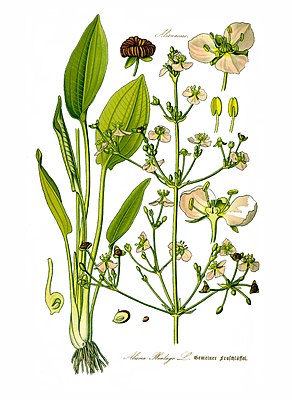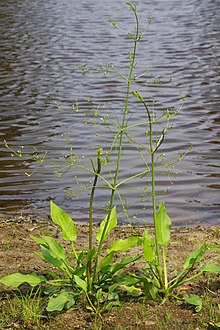Ordinary frog spoon
| Ordinary frog spoon | ||||||||||||
|---|---|---|---|---|---|---|---|---|---|---|---|---|

Common frog spoon ( Alisma plantago-aquatica ), illustration |
||||||||||||
| Systematics | ||||||||||||
|
||||||||||||
| Scientific name | ||||||||||||
| Alisma plantago-aquatica | ||||||||||||
| L. |
The common frog spoon ( Alisma plantago-aquatica ), also known as the real frog spoon , is a species of plant from the family of the frog spoon plants (Alismataceae). This marsh plant is widespread.
description
Vegetative characteristics
The common frog spoon grows in damp locations as a deciduous, perennial herbaceous plant and reaches heights of about 20 to 90 centimeters, the maximum size being achieved by the towering, spreading inflorescence . A tuber , which can reach a diameter of 1 to 3.5 centimeters, serves as a perennial organ .
Emerald and submerged leaves are formed. The emersed, basal leaves have long stalks. Their linear-lanceolate, broadly elliptical to egg-shaped fresh green leaf blades can be longer than 20 centimeters with a width of 1 to 12 centimeters and shows a reticulate nerve and a rounded or weakly heart-shaped blade base. In addition to the typical "air leaves" (emersed leaves), depending on the location, the plants also form flooding, ribbon-shaped "water leaves" (submerged leaves) and, with changing water levels, corresponding narrow-elongated transitional forms. For this reason, it is not always possible to reliably differentiate narrow-growing specimens from the lancet-leaved frog spoon ( Alisma lanceolatum ) in their vegetative state. The common frog spoon is also able to produce hybrids with this kind of thing, which makes a clear assignment even more difficult. Newly sprouting plants of the common frog spoon initially form submerged, petiole-like primary leaves; this is usually followed by a few floating leaves (similar to pondweed ) and only then the large air leaves or - at deeper water points - the flooding diving leaves.
Generative characteristics
The upright, pyramid-shaped, storey-like, spreading total inflorescence is composed of panicley partial inflorescences , develops from June and comes to full development in the summer months. The flower stalks have a length of 1 to 3.5 centimeters.
The relatively small flowers are hermaphroditic and threefold with a double flower envelope . The three green sepals are 1.7 to 3.2 millimeters long. The three whitish to purple-pink, rounded petals are 3.4 to 6.4 millimeters long and have irregular edges. The six stamens are in a circle. The ellipsoid anthers have a length of 0.7 to 1.4 millimeters. There are numerous free, regularly arranged carpels . The ovaries are shorter than the style. The 0.6 to 1.5 millimeter long, more or less upright stylus are only covered in the foremost fifth with small papillae . The flowers do not open until around midday (in contrast to Alisma lanceolatum , which already has open flowers in the morning).
The egg-shaped achenes with a length of 1.7 to 3.1 millimeters usually have one, rarely two grooves and a more or less upright beak on their back.
The number of chromosomes is 2n = 14.
ecology
The common frog spoon is a swamp plant or a rooting water plant , so it lives amphibiously . It is heterophyllous : the lowest leaves are narrow and flood long under water, the upper leaves are broadly lanceolate. It has a bulbous rhizome that serves as a storage organ.
The flowers are homogamous "pollen disc flowers". The stamens are equipped with a basal nectar tissue. Pollinators are particularly hoverflies whose larvae live in the water. Flowering time is from July to August.
The fruits are split fruits that disintegrate into numerous unwettable partial fruits with floating tissue; these are subject to the spread of swimming and can swim for 15 months, and there is also spread of water by water birds . The fruits are cold germs. Fruit ripening is from July to October.
The caterpillars of the polyphagous reed gold owl ( Plusia festucae LINNAEUS, 1758), an owl butterfly (Noctuidae), also feed on the common frog spoon.
Toxicity
The whole plant contains a milky sap that irritates the skin and causes blisters , and the roots also contain a bitter substance and a sharp essential oil . It smells fresh like violet root , but it is poisonous. The plant is deadly poisonous for grazing cattle; Goats, however, tolerate the fresh plant extremely well. The toxic substances are broken down during drying.
Occurrence
The common frog spoon is distributed almost worldwide with two to four subspecies ( Europe , Northwest Africa ( Morocco ), Asia , North America , South America ( Chile ), Australia / New Zealand ). It occurs in subtropical to boreal climates.
In Central Europe it is often found on the banks of ponds , ponds , pools and ditches . It prefers shallow water in a sunny location and nutrient-rich muddy soils. Frog spoons also occur within reed beds and Großseggenried . The main occurrences are nutrient-rich waters and secondary occurrences are nutrient-poor waters. The common frog spoon is a characteristic of the plant society (class) Phragmitetea Tx. et Prsg 1942.
In the Allgäu Alps, it rises at Vilsalpsee in Tyrol up to 1160 m above sea level.
use
The "rhizome" and the leaves taste sharp and are poisonous when fresh. In Russia this species was used against rabies . In Swabia , linen cloths were soaked in the sap and tied to the forehead to treat headaches. In naturopathy , roots and leaves (Herba et radix Alismatis) were used as laxatives.
history

Dioscurides and Pliny referred to a plant as "alisma", "alcima", "damasonion" and "lyron" , the leaves of which are similar to those of the plantain and which grows in water-rich places. The roots should be helpful against the poison of frogs, toads, opium and sea hares ("lepus marinus"). They have also been recommended for the treatment of bowel and menstrual problems. The herb should be used as a plaster against swelling. Galen assessed the "alisma" as "expelling" ("abstersoriam"), as he had found its decoction to be effective in expelling kidney stones.
The northern European herbal books of the 15th and 16th centuries described the common frog spoon in their chapters on plantains . They only recommended the topical use of the herb.
"All hitz zů leſchen / vnd bulging nider zůlegen / Würt fröſch spoonful of herb or water plantain / praised for other crops / and pulled here."
Systematics
The first publication of this species was in 1753 by Carl von Linné under the name "Plantago" (with a triangle behind it) in Species Plantarum , 1, p. 342. According to the code of the nomenclature (ICN, Article 23) these symbols are to be written out. And so the triangle stands for "aquatica". Synonyms for Alisma plantago-aquatica L. are: Alisma subcordatum Raf. and Alisma triviale Pursh .
Valid subspecies of Alisma plantago-aquatica are:
- Alisma plantago-aquatica subsp. orientale (Sam.) Sam. (Syn .: Alisma orientale (Sam.) Juz. , Alisma plantago-aquatica var. Orientale Sam. ): It occurs from the Himalayas to the temperate zones of Asia.
- Alisma plantago-aquatica subsp. plantago aquatica : It occurs from Europe to Korea and from North Africa to Tanzania.
Sources and further information
literature
- Robert R. Haynes, C. Barre Hellquist: Alismataceae. In: Flora of North America. Volume 22, 2000. Alisma plantago-aquatica - online.
- Qingfeng Wang, Robert R. Haynes, C. Barre Hellquist: Alismataceae. In: Flora of China. Volume 23, 2010, p. 87. Alisma plantago-aquatica - online.
- Henning Haeupler , Thomas Muer: picture atlas of the fern and flowering plants of Germany (= the fern and flowering plants of Germany. Volume 2). Published by the Federal Agency for Nature Conservation. Ulmer, Stuttgart 2000, ISBN 3-8001-3364-4 .
- Erich Oberdorfer : Plant-sociological excursion flora . 6th edition. Ulmer Verlag, Stuttgart 1990, ISBN 3-8001-3454-3 .
- Elfrune Wendelberger: Plants of the wetlands - bodies of water, moors, floodplains. Book guild Gutenberg, Munich 1986, ISBN 3-7632-3265-6 . (also: BLV-Verlag, Munich et al. 1986, ISBN 3-405-12967-2 )
- Ruprecht Düll , Herfried Kutzelnigg : Pocket dictionary of plants in Germany and neighboring countries. The most common Central European species in portrait. 7th, corrected and enlarged edition. Quelle & Meyer, Wiebelsheim 2011, ISBN 978-3-494-01424-1 .
- Lutz Roth, Max Daunderer, Kurt Kormann: Poisonous plants plant poisons. 6th edition. Nikol, Hamburg 2012, ISBN 978-3-86820-009-6 .
Individual evidence
- ↑ a b c Ordinary frog spoon. In: FloraWeb.de.
- ↑ Erhard Dörr, Wolfgang Lippert : Flora of the Allgäu and its surroundings. Volume 1, IHW, Eching 2001, ISBN 3-930167-50-6 , p. 139.
- ↑ From Berendes (1902, II / 20) as Aplysia Depilans interpreted (digitized)
- ↑ Julius Berendes : Des Pedanius Dioskurides medicament theory in 5 books. Enke, Stuttgart 1902, Book III, Cap. 159, p. 361 (digitized version)
- ↑ Pliny : Naturalis historia , Book XXV, Chapter 77 (§ 124): Alcima, damasonion . Online edition Chicago (digitized) . Translation Külb 1855, p. 2804 (digitized version )
- ^ Galen : De simplicium medicamentorum temperamentis ac facultatibus, lib. VI, cap. IV (Kühn edition, vol. XI, p. 861): Damasonium aut alisma : (digitized version )
- ↑ Avicenna : Canon of Medicine . Edition Andrea Alpago, Basel 1556, Book II, p. 232: Fistula pastoris (digitized version)
- ↑ Abu Muhammad ibn al-Baitar . Kitāb al-jāmiʿ li-mufradāt al-adwiya wa al-aghdhiya . Translation: Joseph Sontheimer under the title Great compilation of the powers of the well-known simple healing and foodstuffs. Hallberger, Stuttgart Volume II 1842, p. 513 (digitized version)
- ↑ Gart der Gesundheit . Mainz 1485, chapter 61: Barba sylvana water plantain (digitized) ; Chapter 194: Fistula pastoris (digitized version)
- ↑ Hortus sanitatis , Mainz 1491, chapter 58: Barba silvana (digitized version ) ; Chapter 199: Fistula pastoris (digitized version)
- ↑ Hieronymus Brunschwig : Small distilling book , Strasbourg 1500, sheet 32r: ... and water away ... (digitized version )
- ^ Otto Brunfels : Contrafeyt Kreüterbuch. Strasbourg 1532, p. 56 (digitized version)
- ↑ Hieronymus Bock : New Kreütter book. Strasbourg 1539, Book I, Chapter 75 (digitized version)
- ^ Leonhart Fuchs : New Kreütterbuch. Strasbourg 1543, chapter 12 (digitized version)
- ↑ Nicolas Lémery : Dictionnaire universel des drogues simples, contenant leurs noms, origines, choix, principes, vertus, étymologies, et ce qu'il ya de particulier dans les animaux, dans les végétaux et dans les minéraux , Laurent d'Houry, Paris , 1699, p. 22 23: Alisma (digitized version) ; P. 254: Damasonium (digitized version ) . Translation: Complete Lexicon of Materials . Complete material lexicon. Initially drafted in French, but now after the third edition, which has been enlarged by a large [...] edition, translated into high German / By Christoph Friedrich Richtern, [...]. Leipzig: Johann Friedrich Braun, 1721, column 33: Alisma (digitized) ; Sp. 393: Damasonium (digitized version )
- ↑ First publication scanned at biodiversitylibrary.org.
- ^ Alisma plantago-aquatica at Tropicos.org. Missouri Botanical Garden, St. Louis
- ^ Alisma plantago-aquatica in the Germplasm Resources Information Network (GRIN), USDA , ARS , National Genetic Resources Program. National Germplasm Resources Laboratory, Beltsville, Maryland.
- ↑ a b Rafaël Govaerts (Ed.): Alisma plantago-aquatica - data sheet at World Checklist of Selected Plant Families of the Board of Trustees of the Royal Botanic Gardens, Kew. Retrieved August 18, 2016.
Web links
- Ordinary frog spoon. In: FloraWeb.de.
- Ordinary frog spoon . In: BiolFlor, the database of biological-ecological characteristics of the flora of Germany.
- Profile and distribution map for Bavaria . In: Botanical Information Hub of Bavaria .
- Alisma plantago-aquatica L., map for distribution in Switzerland In: Info Flora , the national data and information center for Swiss flora .
- Distribution in the Netherlands [1] (Dutch)
- Map showing the worldwide distribution of the common frog spoon
- Thomas Meyer: Data sheet with identification key and photos at Flora-de: Flora von Deutschland (old name of the website: Flowers in Swabia )
- Description of the frog spoon
- Alisma plantago-aquatica in the Red List of Threatened Species of the IUCN 2013.2. Listed by: Smith, K., 2011. Retrieved January 9, 2014.




